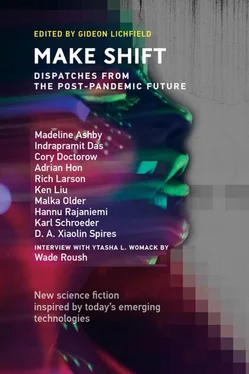The mountainous regions of Southeast Asia, where the Xhong people live, contain some of the most vulnerable ecosystems in the world. Droughts, storms, mudslides, and other consequences of climate change have already wrought havoc with their lives. Each new airport, road, bridge, tunnel, and tourist meant more cement—perhaps the most destructive, poisonous, and unsustainable construction material ever invented by humans—more fossil fuels, more wrecking of forest, soil, aquifers. It meant another step closer toward the day when the area would become uninhabitable by the very people the tourists came to visit.
Moreover, I was acutely aware that my tours were perpetuating a colonialist legacy of violence and exploitation. Though I tried to design my tours with input from Xhong elders and artists and strove to make the villages who hosted my guests equal partners in the business, activists had for years argued that my cultural-immersion tours differed only in degree, not kind, from the exploitative vacation resorts and “cultural showcases” operated by mega corporations and centralized governments, which had little interest in preserving Xhong culture. My customers were of course not overtly exploitative, unlike those who went on sex tours or hunted for exotic animals in Southeast Asia. But they wanted to play at living another culture, to consume a way of life, to find “spiritual meaning” by reducing the traditions and practices of the Xhong into processed trinkets and pseudo-New Age pap that reaffirmed their own choices and sense of superiority. The very notion of tourism in the modern sense is an act of voyeuristic pleasure experienced by the Western (and would-be Western) colonizer subject gazing upon indigenous populations, an act of vicarious subjugation; the global tourism industry is rotten at its foundation.
And yet. And yet.
Without airplanes bringing tourists from across the globe, how was I supposed to keep paying my tour guides and drivers? Without the dollars and euros and WeChat balances, how would the Xhong families who had planned their entire lives around housing and feeding tourists make a living? Without their cameras and phones and excited chatter, who was going to buy all the handicrafts made specifically for them? The Xhong had become dependent on tourism, even as it further eroded their world. Entire villages, which had already suffered enormously through the tourism drought of the pandemic, would now tip over into ruin. While many villagers remained terrified of tourists bearing another wave of infections, many more clamored for the economic life raft they represented. I had no room to think about the planet’s future or the ramifications of colonialist structural inequality when I needed to figure out an immediate way to save the families who were my employees and partners.
Many independent tour providers, including myself, tried to band together to push back against the Ruutuutuu Protests. But like many movements of the era, the Ruutuutuu protesters were a loose coalition with divergent, even contradictory demands. Some were concerned about the cultural and environmental externalities of global tourism, which I sympathized with. But others were motivated by less noble concerns. Some were convinced that tourists from Asia had caused the pandemic in Europe and the United States. Some were isolationists who wanted to seize the opportunity and reverse globalization. Still others believed in conspiracy theories that argued cruise ships and jumbo jets were UN-sanctioned experimental vehicles for Chinese and North Korean spies working under the direction of Russian scientists funded by Bill Gates. Our advertisements and calls for a dialogue made little impact.
There was a cultural shift. Celebrities posting photos of getaways to faraway tropical paradises were now shamed as though they had posted pictures of hunting trophies. People looked at those who flew around in jets the way we used to look at smokers.
Dire warnings were issued about the collapse of tourism-driven developing economies and the hollowing out of indigenous communities. Many of us experienced a sense of helpless rage at the protesters who seemed too blinded by their own zeal to have compassion for those who depended on the cruise ships and jumbo jets. But gradually, as the protests raged on and global tourism numbers remained depressed, we learned to adapt.
The first to try something new were the giant cruise lines and resort owners. As their ships remained docked and their hotels empty, they started to sell “remote tours,” which tapped into VR and telepresence, two technologies that saw unprecedented adoption during the long pause forcefully imposed on much of the world by COVID-19. Many of these packages relied on gimmicks that allowed teletourists to do things they couldn’t have done even in person. Governments, desperate for tourism revenue, readily relaxed various restrictions for these teletourists.
For example, Unicorn Travel, one of the largest cruise lines, ran a program that gave customers the chance to climb the Great Pyramid of Giza when embodied in a telepresence robot, an act that was (and still is) illegal to perform in person. Supposedly, the telepresence robots, being light, electric, and well-padded, posed little risk of damaging the pyramid (and could be programmed to prevent the operator from carving graffiti into the limestone). Similar programs allowed teletourists to stroll through the Taj Mahal at night, to “climb” glaciers in Alaska, to watch tortoises in the Galápagos Islands, to scramble over the ruins of Tulum and Chichen Itza, and numerous similar feats.
But these packages were aimed at the luxury-travel market. They didn’t help the rest of us: the independent tour providers, the cultural experience curators, the local guides who relied on one-on-one tips.
The game changer was the Nene Be, an open-source specification for a small telepresence robotic platform built around single-board computers like the Raspberry Pi. The Nene Be (and its successors) relied on cheap cameras, cheap screens, cheap processors, cheap manipulators and batteries, cheap (but fast) wireless networking, and open-source software. They were easy to make and even easier to operate. They gave the teleoperator the ability to talk to people on the other end, to control their view, and to move around and manipulate objects (with severe limits). They didn’t give one VR-like immersion, but they were just good enough to make you feel like you were doing more than chatting through a webcam. You were there .
The Xhong, like people dependent on the tourism economy around the world, soon built new business models based on the Nene Be. Instead of serving xoi ngai ngai noodles to tourists in person, the stall owners now gave cooking tutorials to paying students from around the world, hosted competitions among teleoperators to see who made the best noodles, and partnered with Southeast Asian grocery stores in the home cities of the teletourists to sell them the ingredients needed to create the dishes at home. Instead of catering to the needs of a tourist family who wanted to pretend to be rice farmers for a week, now Xhong families could simply set up a few Nene Bes near the paddy (fenced in so they didn’t accidentally fall into the water—though telepresent “paddy races” were also a thing for some) and charge people who wanted to drop in from time to time to do some telepresent farming or help chase off vermin as a way to unwind. Instead of selling tourist-pleasing wax-dyed prints, Xhong artisans now could teach workshops, take on teletourist apprentices, or license their unique designs for 3D printing or one-off dyeing in the tourists’ own countries. The possibilities were endless.
Involving no jets traversing oceans, no SUVs bouncing over winding mountain roads, no giant staff to tend to the passengers’ every whim, even accounting for the investment in network infrastructure, a visit through a Nene Be requires less energy than it takes to keep the lights on in an average American house for an hour. Because a teletour can be booked with so little friction, the average visit lasts only twenty-eight minutes. In the trade, we call them “telejaunts” or just “jaunts.”
Читать дальше












